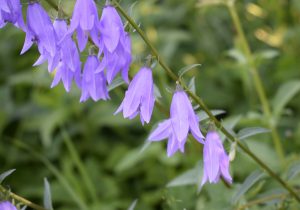Creeping Bellflower
 Campanula rapunculoides resembles our native harebell (Campanula rotundifolia) and is often mistaken for that species. The difference between them is stark and important, for creeping bellflower is the non-native species that tends to crowd things out, politely put, and is much larger than the diminutive, delicate harebell. While both are in the Campanula genus, creeping bellflower has larger flowers, height, leaves and growth pattern, producing a profusion of seeds each season. It also readily reproduces via rhizomes and tubers underground. In MN it is considered invasive, ranked on the MISAC (Minnesota Invasive Species Advisory Council) list as “minimal/established”. This is the same level as many other non-natives, for example, mullein, motherwort and white campion flowers which also spread quite readily once they are established. Compare this ranking to the noxious weed, common tansy, listed on the same site as “severe/established”, a higher level of concern. All this said, creeping bellflower, while very pretty, bottom lines deserves eradication from your garden.
Campanula rapunculoides resembles our native harebell (Campanula rotundifolia) and is often mistaken for that species. The difference between them is stark and important, for creeping bellflower is the non-native species that tends to crowd things out, politely put, and is much larger than the diminutive, delicate harebell. While both are in the Campanula genus, creeping bellflower has larger flowers, height, leaves and growth pattern, producing a profusion of seeds each season. It also readily reproduces via rhizomes and tubers underground. In MN it is considered invasive, ranked on the MISAC (Minnesota Invasive Species Advisory Council) list as “minimal/established”. This is the same level as many other non-natives, for example, mullein, motherwort and white campion flowers which also spread quite readily once they are established. Compare this ranking to the noxious weed, common tansy, listed on the same site as “severe/established”, a higher level of concern. All this said, creeping bellflower, while very pretty, bottom lines deserves eradication from your garden.
 Chances are you have enjoyed this flower with its nodding bells that open June through October. Ever since childhood, I have had a special appreciation for them as well. The eye-catching, purple bells rise from the foliage on stems that are either erect or quite often at an angle. Unlike its native counterpart, creeping bellflowers grow up one side of the stem in a long raceme (or spike pattern), each flower’s five, pointed petals hanging downward. The calyx has five, pointed sepals that are lobe-shaped and point away from the flower.
Chances are you have enjoyed this flower with its nodding bells that open June through October. Ever since childhood, I have had a special appreciation for them as well. The eye-catching, purple bells rise from the foliage on stems that are either erect or quite often at an angle. Unlike its native counterpart, creeping bellflowers grow up one side of the stem in a long raceme (or spike pattern), each flower’s five, pointed petals hanging downward. The calyx has five, pointed sepals that are lobe-shaped and point away from the flower.
